The Nagoya University Museum's new special exhibition, "Crab Collection '18: Functional variation of crab chelae," is full of playfulness -- from its name inspired by Paris Fashion Week (called "Paris Collection" in Japan), to the "Crab Election" where visitors can vote for their favorite crab. In fact, the content of the exhibition is the result of advanced research that reveals the variety in crab claw form and function, as well as the universality that lies within.
When we hear the word museum, we often picture a silent space full of fossils or animal specimens. To say something is a "museum piece" is like calling it an antique, basically another way to say it's obsolete. Upon entering the backyard of the Nagoya University Museum, however, you see that it's not only a traditional collection of artifacts, but also indeed a dynamic space for knowledge. The museum is served by a small group of seven full-time teaching staff who engage in different kinds of research, from the origins of man, to mysterious spheres that roll around beaches, to the common dandelion. Upon first glance there seems to be no connection, but staff say that regular exchange with researchers from different fields reveals unexpected connections and developments. The Crab Collection also features one of those mysterious spheres. Exchange between different cultures is a major feature of the museum's research, and researchers agree that their work has been possible only in the museum. It is an advantage that the museum is in a university, as they have access to specialists and partners necessary to their research, and no shortage of interested students who will work for them.
The results of their research are exhibited in the museum, which makes them different from other researchers at the university, but it's also a pleasure to have their work seen by so many people. It makes for a small but exciting and unique base for research.
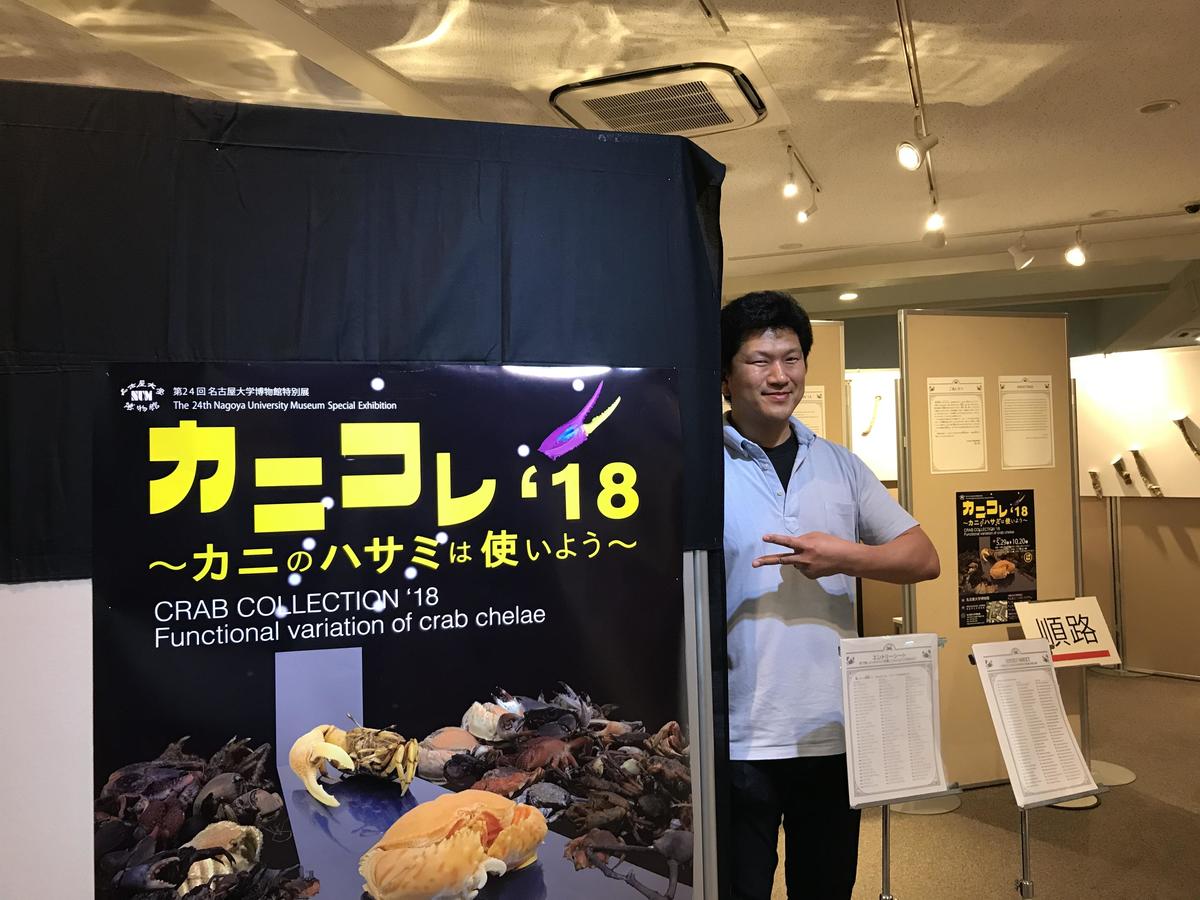 Lecturer Shin-ichi Fujiwara stands at the entrance of Crab Collection '18. In the poster, both the models who “crab walk” down the runway of the fashion show and the audience are crabs.
Lecturer Shin-ichi Fujiwara stands at the entrance of Crab Collection '18. In the poster, both the models who “crab walk” down the runway of the fashion show and the audience are crabs.
Lecturer Shin-ichi Fujiwara is the head of the Crab Collection. He's an expert on the relationship between the musculoskeletal system and its function in animals. For example, from the shape of dinosaur bones, he surmises how they walked, or what posture they slept in. This includes crab claws, which have developed through changes in the tips of crab legs, and big advantage is that it's easy to collect specimens -- things like snow crab legs that he ate the meat inside are also subjects of his research.
There's actually a large variation in crab types. Some have powerful claws so that they use to smash shells and bring them to their mouths, while others cleverly use their pointed claws to wrench open shells. There's left-handed crabs mixed in with right-handed crabs with large right claws. Sad to see is the male fiddler crab. His larger claw cannot reach his mouth, and he uses it only as a prop while he dances to attract a mate, or to hit opponents in a fight. "The female can easily use both claws to eat, but the male eats with just one smaller claw. Does he really want to attract a female so much despite the risk?" Fujiwara himself wonders. The fiddler crab has a kind of simple-minded air, so I gave him a vote for his unique personality in the Crab Election.
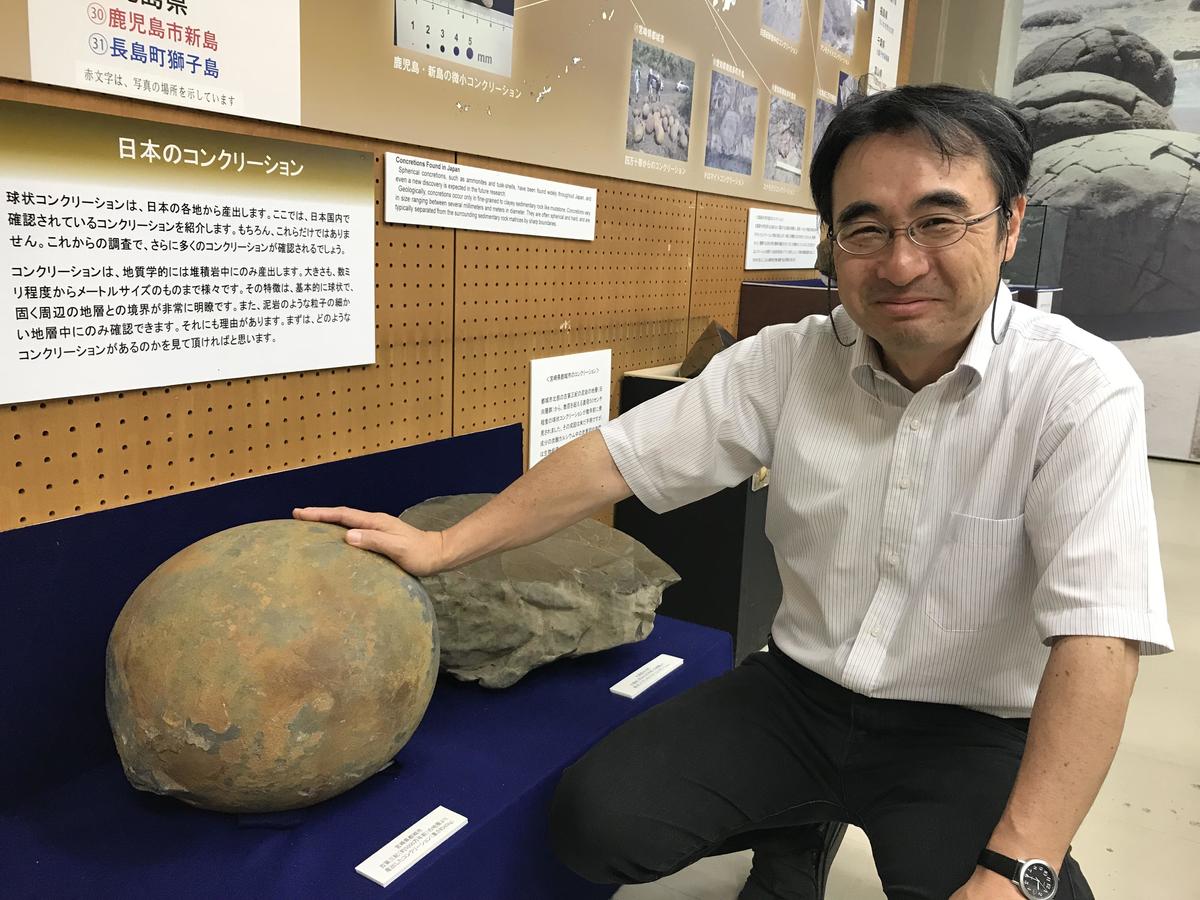 Professor Hidekazu Yoshida with a concretion discovered with in Miyakonojo City, Miyazaki Prefecture, from a layer stratum about 50 million years old. It weighs 40 kilograms.
Professor Hidekazu Yoshida with a concretion discovered with in Miyakonojo City, Miyazaki Prefecture, from a layer stratum about 50 million years old. It weighs 40 kilograms.
The mysterious sphere that was shown at the Crab Collection is called a concretion, and inside it contained a fossilized crab. There was a notice about a separate exhibition about concretions in another room. A mini version of last year's special exhibition "Mysterious spherical concretions -- Ultimate fossil preservation system" is now part of the permanent exhibition. As said in the exhibition title, concretions have a deep connection with fossils.
Professor Hidekazu Yoshida is in charge of the concretions. When the museum opened in 2000, he moved there from the research lab at the Japan Atomic Energy Agency (former Power Reactor and Nuclear Fuel Development Corporation) in Mizunami City, Gifu Prefecture. I was surprised to hear he came from an atomic energy background, but as a geologist who specializes in the movement of matter in geological formations, he was involved in fundamental research into the safety of the underground disposal of radioactive waste. Water holds the key to how matter moves beneath the earth, the same as with concretions.
Concretions are hard spherical rocks that range in size from a few millimeters to giants over a meter in diameter. Fossil researchers actually call them nodules, and they have been well known for over 100 years because well-preserved ammonites and other fossils are often found inside. When nodules are discovered, they are dug up and split open, and any fossils revealed are collected. The rocks themselves were discarded.
Yoshida was interested in the used-up nodules. Why do they preserve fossils so well? Why are they spherical? Several years ago when his research was making progress, a paleontologist brought him a tusk shell concretion that was found in a 16 million year-old layer of stratum in the Yatsuo district of Toyama City, which is famous for the Kaze no Bon dance festival. The concretion is a few centimeters in diameter and the tapering tubular shell was protruding from the rock like an arrowhead tuber. Tusk shells are molluscs that still exist today, living in mud at the bottom of the sea. This shell had fossilized and was beautifully preserved. For a researcher of extinct plants and animals this wasn't anything rare or fantastic, but Yoshida was excited. He quickly organized an interdisciplinary research team, collected the sample at Yatsuo, and began analyzing it.
They found that the hard rock was made of calcium carbonate, which is almost insoluble in water, and discovered that it had formed from the carbon in the dead snail's body mixing with calcium in the ocean water contained in the surrounding seabed. They also found that it had grown spherically from the mouth of the snail, like a balloon inflating. It formed extremely fast, only taking a few weeks to reach a radius of one centimeter. It had been preserved as if the compounds of the shell had frozen instantly.
They additionally analyzed over 100 concretions from around the world, and this past spring announced that they had generalized the growth mechanism as a formula whereby meter-sized concretions could be formed in a matter of months or years. They had answered both the question of why fossils are preserved so well inside, and why concretions are spherical.
Yoshida believes this mechanism could be applied to cover the surface of concrete structures with calcium carbonate -- essentially that it could potentially be used for sealing -- and is continuing with this research. Additionally, concretions with surfaces covered in iron have also been discovered in the Utah desert in the US. Similar ones were found on Mars, and they're thought to hold clues to learning about the environment on the planet.
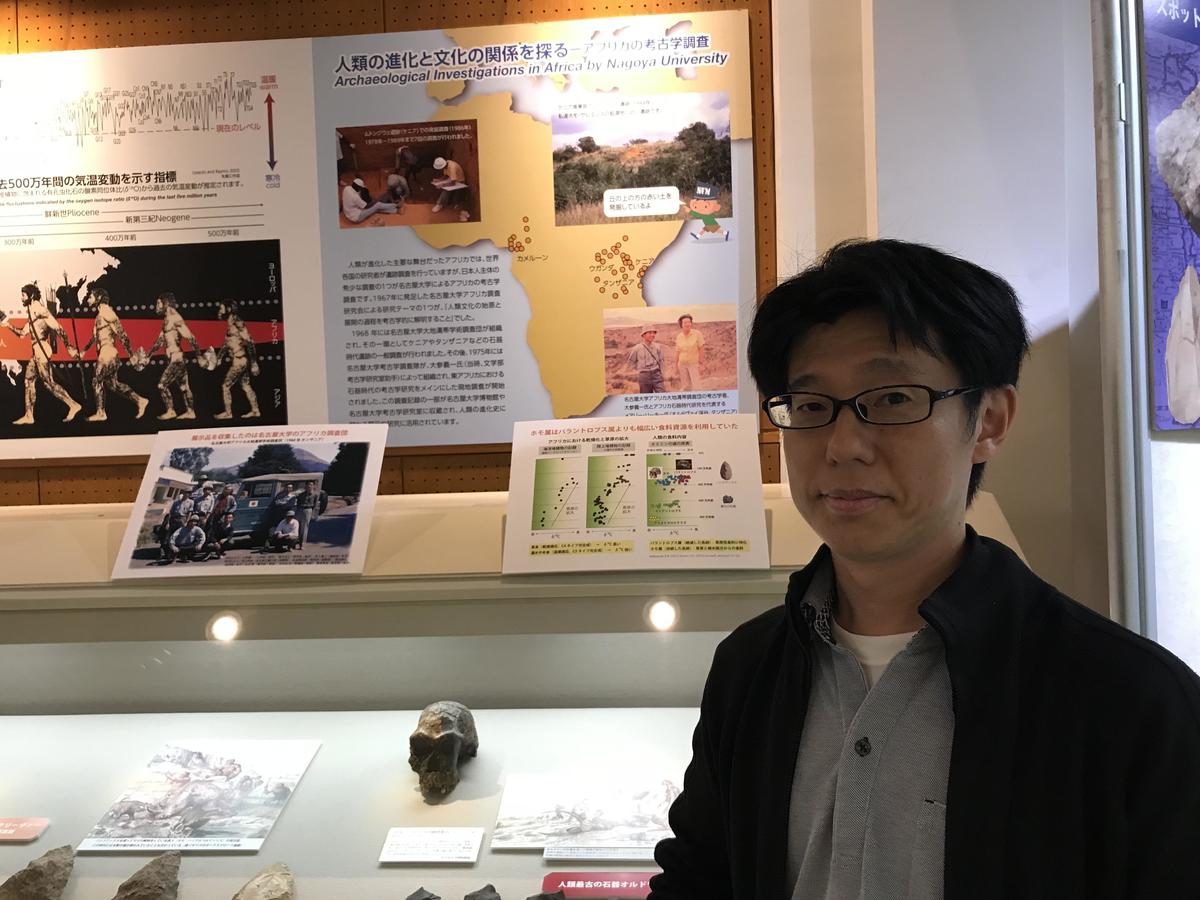 Lecturer Seiji Kadowaki stands in the human evolution corner of the permanent exhibition, where a collection of stone implements are displayed.
Lecturer Seiji Kadowaki stands in the human evolution corner of the permanent exhibition, where a collection of stone implements are displayed.
"I'm glad I came to the museum," says archaeology lecturer Seiji Kadowaki. He is heading a Paleolithic excavation in Jordan, an era that stretched from 15,000 to 70,000 years ago. During this time, it is believed that Neanderthals and early Homo sapiens -- the ancestors of modern humans -- coexisted in the Middle East. Using stone implements as clues to their behavior, his research endeavors to discover why Homo sapiens lived on while Neanderthals died out. It's magnificent research on human history.
Using the size and shape of the stone implements, along with fossils of plants and animals found nearby, they attempt to reveal the behaviors that fossils cannot show. Invaluable is the contribution of Fujiwara, who can gather information about a bone's function from its form. Additionally, while archaeologists normally analyze stone implements after removing calcium carbonate (calcite) particles from the surface, Yoshida taught him that these particles hold information about the natural environment at the time.
Associate Professor Michiko Niimi also works in the field of archaeology, but in environmental archaeology. She has excavated historic ruins in Hokkaido and other areas of Japan, as well as in East Asia, and analyses bones, shells and tools found at the sites to gather clues about the lives of ancient people. Then there's Associate Professor Kazuhiro Tsukada, who is working to reveal more about the history of the earth. Using geological surveys of Mongolia, he is researching the formation of the Central Asian Orogenic Belt that divides China and Siberia, as well as the collision process of East and West Proterozoic Gondwana based on geological surveys of Antarctica. It's really large scale stuff.
As the researchers have such different specialties, their viewpoints are also completely different. They exchange with one another not only a variety of useful information from the field, but also their different perspectives. This kind of interaction can completely change how someone looks at something. That's the kind of potential hidden in this museum.
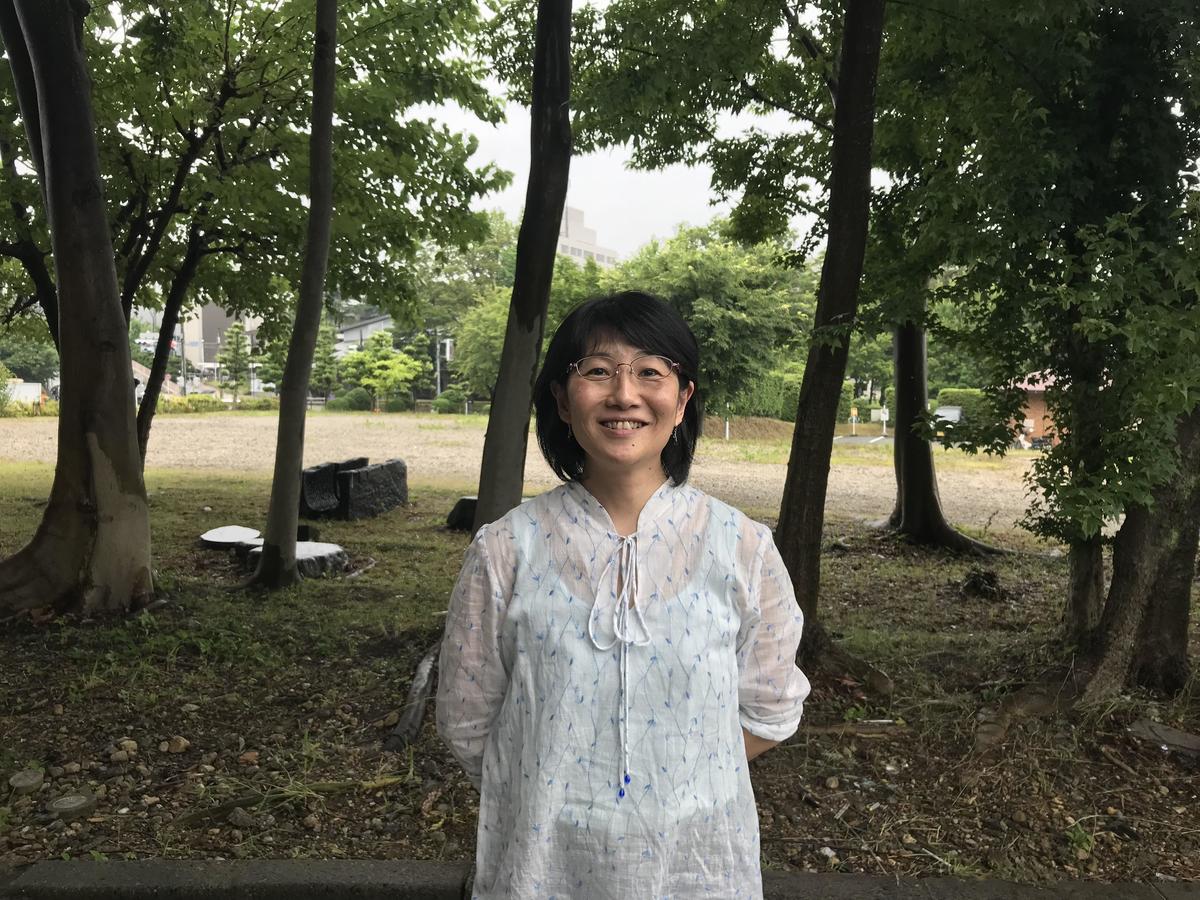 “You find something different than predicted, and then think, ‘Why?’ Then you connect it further to universal rules. That is the epitome of research,” says Associate Professor Sachiko Nishida.
“You find something different than predicted, and then think, ‘Why?’ Then you connect it further to universal rules. That is the epitome of research,” says Associate Professor Sachiko Nishida.
On the flipside of that strength is the downside of perhaps not being viewed as a specialist. "That's exactly why I have to deliver acceptable results," says Associate Professor in plant ecology, Sachiko Nishida.
Her unique career began with studying history in the Kyoto University Faculty of Letters, as she felt human history was much more profound than apparently simple science. She then worked for three years as a TV director at NHK before finally becoming a researcher. Making TV programs was fun, but she received a surprise when she was put in charge of a show about Yakushima cedar and other plants. She had been interested in living things since she was a child, but had never thought that plants could be the same kind of living beings as her as they grow and spread in a matter-of-fact way. She also gained a great sense of respect for the way plants reliably sense the seasons and bloom.
Nishida is currently involved in reproductive interference, a topic that has gained attention in recent years. When closely-related plants accidentally exchange pollen, sometimes seeds don't develop properly. The potential for a negative effect to occur depends on the species and combination of plants, and reproductive interference is the mechanism that the species which experiences the stronger adverse effect begins to disappear. Plant ecology looks at why plants are currently distributed in the way they are. It's believed that plant distribution changes due to competition for resources like light, water, and nutrients, but Nishida believes that reproductive interference may play an equally or more important role. Mistakes cause increased diversity -- this is the wonder of living things.
In Japan, despite the introduction of common dandelions from abroad, there are some areas where the native dandelions still remain. In Okinawa there are plants that, once every six years, all bloom at once then wither away, and Nishida is working to verifying her hypothesis that this is a strategy to overcome problems due to a mistaken way of exchanging pollen.
Nishida wonders if the disappearance of Neanderthals is the outcome of reproductive interference. "It may just be a wild idea," she laughs.
In late 2013 and 2014, Nishida was in charge of a somewhat unusual exhibition at the museum: "Beyond the Ice Walls -- 'Nylon Rope Case' and the life of Shigeo Ishioka." The inspiration for Yasushi Inoue's novel "Ice Walls," Shigeo Ishioka lost his brother in a mountain accident after a state-of-the-art nylon climbing rope was severed. He then tested nylon climbing ropes himself and drew attention to their dangers. Yet when an Osaka University professor performed a public test of the ropes they didn't cut, so it was ruled that the accident happened due to the way the rope had been used by Ishioka's brother. As a matter of act, the rock corner with which the ropes contacted in the test was made dull intentionally. Because of this falcified test results, the nylon ropes remained in use and further lives were lost.
Twenty years after Ishioka made his appeal; a safety standard for climbing ropes was finally set for the first time in the world. Because Ishikawa was a Nagoya University Department of Engineering alumnus, the related documents were gifted to Nagoya University. The exhibition also covered the current issue of the social responsibility held by scientists and engineers, and garnered a lot of attention. The exhibition then toured across the country.
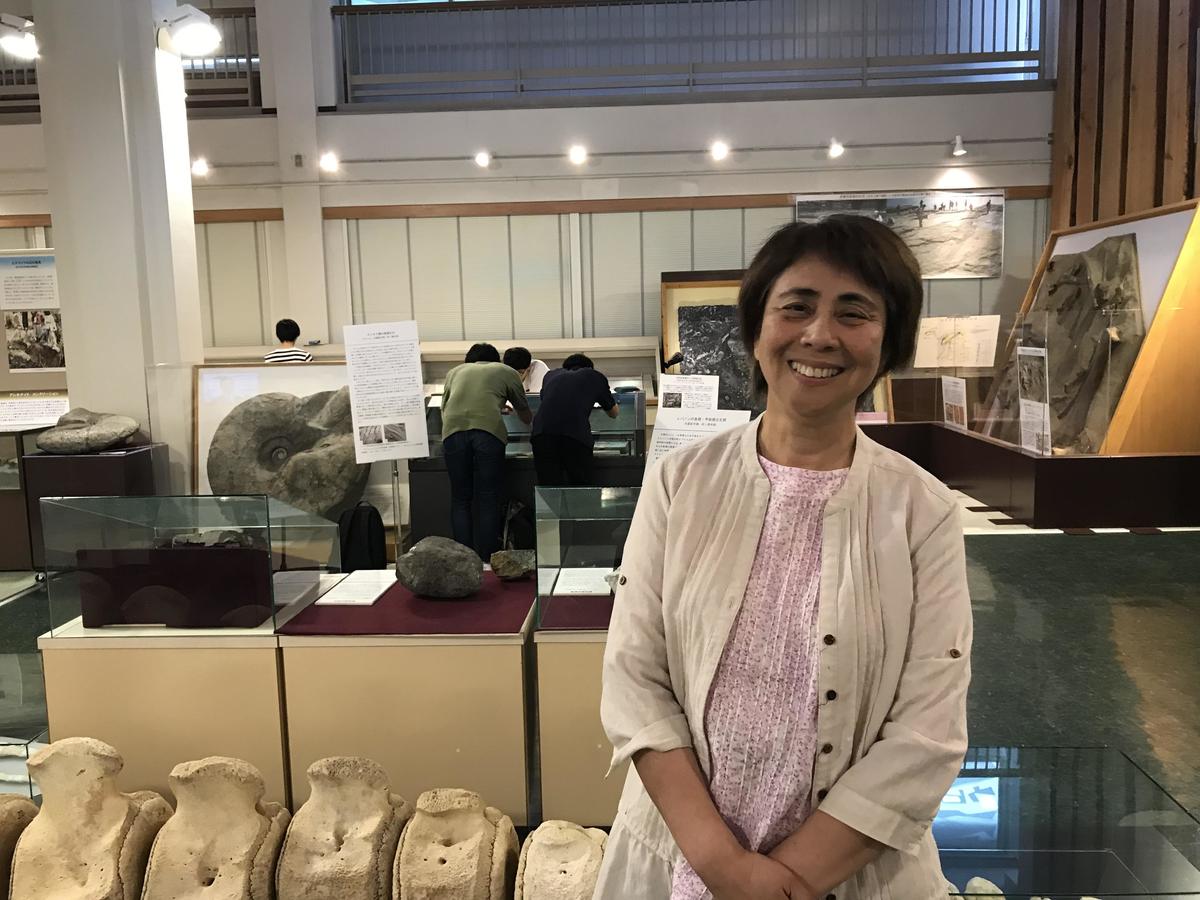 Curator Masumi Nozaki not only does the displays herself, she also engages in a variety of activities like running the museum friends association and organizing seminars for children. ”I cover everything in the museum,” she says.
Curator Masumi Nozaki not only does the displays herself, she also engages in a variety of activities like running the museum friends association and organizing seminars for children. ”I cover everything in the museum,” she says.
Masumi Nozaki has supported the museum as a curator since its founding. Nagoya University Museum is unique in having a museum friends association, and with some 500 members, it has a strong connection to the local community. A popular activity for children is the "micro exploration party," an event where they can use one of the museums three electron microscopes to take pictures and make them into postcards to take home. There's also an earth workshop where children head out to the field to learn.
Professor Tatsuo Oji has served as museum director since 2014. Having visited many museums, he says, "I really realized that our museum has a remarkably strong connection to society and the people outside of the university." While continuing to fulfill that role, he says, "I want our museum to be the leader of the university's field- and specimen-based natural history and archaeology research." Field and specimen research is looking at nature exactly as it is. As we've seen here, the wider variety of viewpoints you have, the more things you can see. A university museum full of such a diverse viewpoint is undoubtedly significant for research and education throughout the entire university.
I'd like to see the Nagoya University Museum used even more as a place for internal and external exchange.

 Subscribe to RSS
Subscribe to RSS